

Adolescent Literacy Toolkit. Adolescent Literacy Toolkit Mathematics Lesson Plans, Narratives, and Literacy Q&A Lesson Plans and Narratives The goal of the sample lesson plans is to show content-area high school teachers how they can use literacy strategies to help high school students learn core content and concepts.
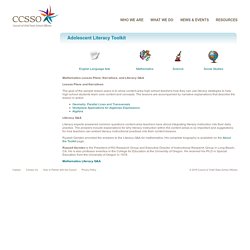
The lessons are accompanied by narrative explanations that describe the lesson in action. Literacy Q&A Literacy experts answered common questions content-area teachers have about integrating literacy instruction into their daily practice. Russell Gersten provided the answers to the Literacy Q&A for mathematics. Russell Gersten is the President of RG Research Group and Executive Director of Instructional Research Group in Long Beach, CA. Curriculum Resources: Public Speaking. Energy Expo Students work in groups to develop hands-on exhibits and make presentations to teach others.
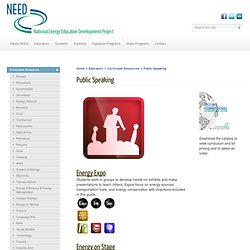
Expos focus on energy sources, transportation fuels, and energy conservation with directions included in this guide. Energy on Stage This resource includes plays and poems on energy sources and energy conservation, with individual teacher guides that have expanded vocabulary and extensions. Energy Rock Performances Student rock bands write songs and sing about energy sources, electricity, and conservation and efficiency in this entertaining activity. Audiences learn more from these energy rock stars as they tell their stories to interviewers out to get the latest energy scoops. Teacher and student instructions are included, along with sample songs and interviews. Visual Arts - Education Closet. Hot Topics in Adolescent Literacy. Hot Topics in Adolescent Literacy Students will need advanced literacy skills — the ability to understand and analyze a variety of texts and to write and communicate persuasively — to succeed in life after high school.
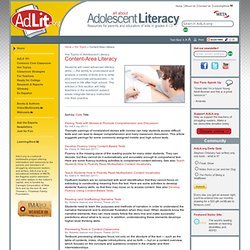
The articles in this section will help teachers in the academic subject areas integrate literacy instruction into their practice. Sort by: Date Title Pairing Texts with Movies to Promote Comprehension and Discussion By: AdLit.org (2011) Thematic pairings of novels/short stories with movies can help students access difficult texts and can lead to deeper comprehension and lively classroom discussion. Develop Fluency Using Content-Based Texts By: Elaine K. Fluency is the missing piece of the reading puzzle for many older students. Structured Notetaking. Classroom Strategies Background Structured Notetaking is a strategy that helps students become more effective note takers.
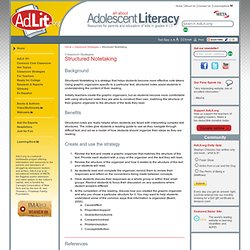
Using graphic organizers specific to a particular text, structured notes assist students in understanding the content of their reading. Initially teachers create the graphic organizers, but as students become more comfortable with using structured notes they are able to construct their own, matching the structure of their graphic organizer to the structure of the texts they read. Benefits Structured notes are really helpful when students are faced with interpreting complex text structures. Create and use the strategy. Previewing Texts in Content Classrooms. By: Roberta Sejnost and Sharon Thiese Textbook previewing strategies focus not only on the structure of the text — such as the table of contents, index, chapter introductions, and so forth — but on a content overview, which focuses on the concepts and questions covered in the chapter and their interrelationships.
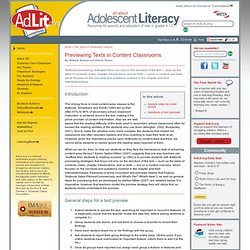
Introduction The driving force in most content-area classes is the textbook. Woodward and Elliott (1990) tell us that often 67% to 90% of secondary school classroom instruction is centered around the text, making it the prime provider of content information. Also we are well aware that the reading difficulty of the texts used in secondary school classrooms often far exceed the reading abilities of the students who use them (Allington, 2002; Budiansky, 2001). What can we do, then, to help our students as they face the tremendous task of achieving content-area literacy? General steps for a text preview Variations of text previews Name that feature. Analytical Writing in the Content Areas. By: Amy Rukea Stempel (2010) Because writing is thinking, the organization of students' writing reflects both the structure of their thinking and the depth of their understanding.
Students should be writing in all their classes, explaining what they know and how they know it. Thus, it's essential for content-area teachers to give students meaningful analytical writing assignments. Read An Introduction to Analytical Text Structures for more information and graphic organizers to help with writing instruction. Introduction Non-language arts teachers often become nervous when they learn they are supposed to teach writing. What does this mean? Good expository writing exudes style and voice; however, subject-area teachers are not responsible for teaching these skills. Artistic, creative writing has no place in the other subject areas.
That said, what are non-language teachers responsible for when teaching thinking and writing? What supporting evidence is relevant to the thesis? Thesis Statement. Transition to Common Core - home.